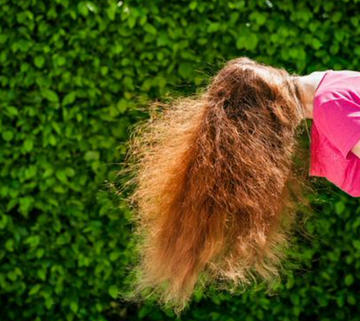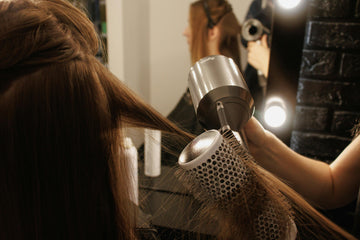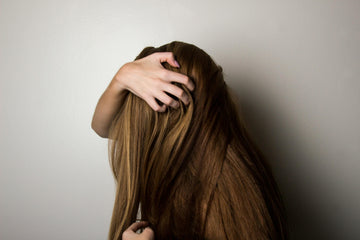Static hair acting like a stage 5 clinger? Here’s how to stop it
Static—aka the unexpected guest no one invited—has a way of showing up at the worst possible moments. You step out of the house feeling like that girl, but the second you pull off your sweater or run your fingers through your hair, your strands rebel. Suddenly, your sleek, polished look is replaced with gravity-defying flyaways that refuse to chill.
Winter is prime time for static hair, thanks to dry air, indoor heating, and all those cozy (but guilty) wool and synthetic fabrics. And while we love a good holiday sweater moment, no one’s trying to look like they just stuck their finger in an electrical socket.
The good news? Static hair is NOT here to stay. A few simple tweaks to your routine—think hydration, the right tools, and a little anti-static magic—can keep your strands smooth and totally under control. Ready to ditch the frizz-fest? So are we!
Why does hair get static-y?
Science class refresher—static happens when your hair picks up extra electrons from dry air, friction, or synthetic fabrics. The result? Strands that repel each other like a bad first date—awkward, unmanageable, and impossible to ignore.
Here’s the deal, the drier your hair, the more it acts like a magnet for static. That’s why winter is basically flyaway season—cold air outside + cranked-up indoor heating = ZERO moisture in the air (and in your hair). The lack of humidity leaves your strands parched, making them more likely to attract an electric charge. And once that charge builds up? Your hair starts standing up like it's personally offended by gravity.
But dry air isn’t the only culprit. Ever notice how your hair goes full science experiment after pulling off a sweater or a beanie? That’s because materials like wool, polyester, and acrylic create friction, which transfers electrons to your hair. The more friction, the more charge—and the more your strands start acting like rebellious teenagers, refusing to stay in place.
And let’s talk about brushing. Running a plastic brush through dry hair is like swiping a credit card through a static generator. The more you brush, the more you charge your hair, turning what should be a sleek finish into a full-blown flyaway fiasco.
So, what’s the fix? It all comes down to moisture, the right materials, and a few little tricks to stop static in its tracks.
First—hydration
Moisture is your hair’s personal bodyguard against static—without it, your strands are defenseless against electric charge. Dry hair is basically a magnet for static, which means the key to keeping flyaways under control starts in the shower.
Here’s how to lock in hydration and keep static at bay.
✔ Shampoo smarter – Avoid shampoos with harsh sulfates (like sodium lauryl sulfate), which strip your hair of its natural oils. Instead, opt for a hydrating formula that cleans without over-drying. If your scalp can handle it, try washing your hair less frequently to preserve those essential oils.
✔ Condition like you mean it – Your conditioner isn’t just for making your hair soft (believe it or not) it’s your first line of defense against dryness. Use a rich, moisture-packed conditioner after every wash, focusing on the mid-lengths and ends where hair tends to be the driest.
✔ Leave-in conditioners are your new best friend – A lightweight leave-in conditioner adds an extra layer of moisture, keeping your hair smooth and less likely to pick up static throughout the day.
✔ Deep conditioning = revolutionary – A weekly hair mask or deep conditioning treatment can replenish lost moisture, making your hair more resilient against dryness and static. Look for ingredients like shea butter, coconut oil, and hyaluronic acid for that extra hydration boost.
✔ DO NOT skip the heat protectant – If you’re using heat tools, a thermal protectant is non-negotiable. Hot tools can zap moisture from your hair, making it even more prone to static. A good heat protectant acts like a barrier, keeping hydration locked in.
Bottom line? The more moisture your hair holds onto, the less likely it is to turn into a static-charged mess. Now, we’ve gotta look at another sneaky culprit—your hairbrush.
Choose the right brush
Not all hairbrushes are created equal—especially when it comes to static. In fact, the wrong brush can make things worse by creating extra friction, turning your hair into a full-blown science experiment.
So, what’s the best brush for keeping static away? Swap out your plastic brushes ASAP and go for these instead.
✔ Boar bristle brushes – These distribute natural oils from your scalp down the length of your hair, keeping strands hydrated and less likely to pick up static. Bonus: they make your hair shinier, too.
✔ Wooden combs – Unlike plastic, wood doesn’t conduct electricity, which means less friction and fewer static flyaways. It’s a simple switch with a big payoff.
✔ Metal brushes (yes, really!) – It might sound counterintuitive, but metal can actually help neutralize static. If you’re constantly battling flyaways, a metal-bristled brush could be your secret weapon.
✔ Ion-infused brushes – Some brushes come with ion technology that helps counteract static electricity.
While they won’t perform miracles, they can make a noticeable difference if static is a daily struggle.
Important tip: Whatever brush you use, avoid over-brushing. Too much friction can strip your hair’s natural oils and make static worse. Instead, brush just enough to detangle and smooth things out—no need for 100 strokes a day (sorry, old-school hair myths).
Now that we’ve tackled brushes, there’s something else you probably haven’t considered—your ENVIRONMENT. Yes, really.
Dry air? Meet your new bestie—Humidity
Dry air is basically a *static factory*. The less moisture in the air, the more likely your hair is to turn into a frizz-and-flyaway situation. And guess what? Indoor heating in the winter makes things even worse by sucking every last drop of moisture out of the air (and your hair).
The fix? Bring in the humidity. A little extra moisture in your environment can make a huge difference in keeping static at bay. Here’s how:
💨 Use a humidifier – This is hands-down the best way to add moisture back into the air. Keep one running while you sleep, and you’ll wake up with hair that’s less dry—and less prone to static.
💦 Take steamy showers – We’re not saying you should turn your bathroom into a full-on sauna, but letting a little steam build up before stepping out can help add some much-needed moisture to your strands.
🌿 Add houseplants – Certain plants (like peace lilies and spider plants) naturally increase humidity levels. Plus, they look cute, so it’s a win-win.
🥤 Stay hydrated – Remember, hydration starts from the inside out. If you’re not drinking enough water, your hair will feel it—so keep that water bottle close.
The more moisture you can introduce into your surroundings, the better your hair will behave.
Ditch the synthetic fabrics
Your outfit might be working against your hair. Ever noticed how static gets worse when you pull a sweater over your head or wrap yourself up in a cozy scarf? That’s because synthetic fabrics like polyester, acrylic, and wool create friction, which leads to unwanted flyaways and that dreaded electric charge.
But don’t worry, you don’t have to ditch your winter wardrobe completely—just make a few strategic swaps to keep static hair under control.
Opt for natural fabrics – When it comes to keeping static at bay, cotton and silk are the real MVPs. Unlike synthetic fabrics that practically beg to zap your strands with electricity, these natural options keep things smooth and under control. Less friction, fewer flyaways, and way fewer bad hair days.
Switch to a silk scarf – Love wrapping up in a cozy scarf but hate the hair disaster that comes with it? Wool might keep you warm, but it’s also a static magnet. Swap it for a silk or satin-lined scarf, and you’ll stay toasty without turning your hair into a frizz fest. Warmth and sleek strands? Now that’s a winter win.
Sleep on a silk pillowcase – If you’re serious about kicking static hair to the curb, consider this your VIP pass to smoother strands. Not only will you wake up feeling like royalty, but silk cuts down on friction, keeps moisture locked in, and helps prevent that dreaded dryness that turns your hair into a static-charged mess. Beauty sleep just got an upgrade.
By making these small changes, you’ll minimize static buildup and keep your hair looking smooth, no matter how many layers you need to stay warm.
Use anti-static sheets (yes, the laundry kind)
Desperate times call for creative solutions. If your hair is acting up and you don’t have styling products on hand, grab a dryer sheet. These little lifesavers neutralize static in an instant—just smooth one over your hair and watch the flyaways disappear.
Top tip: Keep a few tucked in your bag or your car for hair emergencies. They work on clothes, too, so if your sweater is clinging in all the wrong places, you’ve got a quick fix.
Style smart with the right products
When static strikes, a little extra hold goes a long way. The trick is choosing lightweight, hydrating styling products that keep flyaways under control without making your hair stiff or greasy.
– Hair serum: Just a dime-sized amount smoothed over the lengths of your hair can keep static at bay while adding a healthy shine.
– Hairspray: Lightly mist your brush, then comb through your hair for an even, natural-looking finish that holds everything in place.
– Dry oil spray: Adds instant moisture and smoothness without weighing hair down—perfect for touch-ups throughout the day.
The old “hand cream trick”
No anti-static spray? No problem. If you’re in a pinch, rub a tiny bit of hand cream between your palms, then lightly smooth it over your hair. The added moisture will tame flyaways without making your strands feel sticky or greasy. Just be sure to use the tiniest amount—you’re moisturizing, not deep conditioning. And us girlies may not like static, but we sure as hell don’t like greasy locks, either.
Finally, isn’t frizz the same as static?
Short answer: nope. Long answer: still nope, but let’s break it down.
Static happens when two unlike objects rub together, creating an electric charge that makes your hair stand on end (thanks, winter sweaters). Frizz, on the other hand, is all about moisture—or the lack of it. When your hair’s cuticle isn’t smooth, it absorbs humidity from the air, leading to puffiness, flyaways, and that big-hair energy in ALL the wrong ways.
In other words, static is a winter problem, while frizz thrives in summer. Though they are different—they both have one major fix: hydration. Keeping your hair moisturized, choosing the right fabrics, and using anti-static tricks will help you fight static now and keep frizz at bay later. So, if your hair is standing on end or puffing up like a soufflé, you’ve got the tools to keep it sleek and unbothered. Because we’re all unbothered queens deep down, and our hair better start acting like it.




